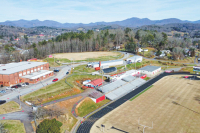Southside story: Bid awarded in contentious timber project
 The rare green salamander requires moist, rocky habitats like those found on Brushy Mountains. Lori Williams/NCWRC photo
The rare green salamander requires moist, rocky habitats like those found on Brushy Mountains. Lori Williams/NCWRC photo
Five years after it first proposed the controversial Southside Timber Project, the U.S. Forest Service has awarded a timber bid to cut the first 98 acres of 317 acres to be harvested — earning sharp criticism from environmental groups who say the project will destroy rare old-growth forest.
“The Southside Timber Sale was a bad idea when it was announced five years ago, and it is still a bad idea today,” said Susannah Knox, senior attorney for the Southern Environmental Law Center. “By ignoring overwhelming public opposition and moving forward with this reckless project at rock-bottom prices, USFS leaders show they are more interested in logging old-growth forests — regardless of the cost — than listening to experts and scientific research.”
In a final environmental assessment completed in February 2019, the Forest Service laid out its plans for a project it said would improve forest health, diversity and wildlife habitat in the Nantahala National Forest in southeastern Macon County and southern Jackson County. The project aims to use timber harvest to create 317 acres of young forest spread across 23 separate stands in a 19,000-acre project area. More than one-third of the openings created will be 1 acre or less, with an average opening of 22 acres on the remaining stands. Project plans also include establishing native nectar- and pollen-producing species in wildlife openings, log landings and roadsides to benefit native pollinators; rehabilitating existing wildlife openings; and improving fisheries habitat in Scotsman Creek.
During a scoping period conducted in 2017, the Forest Service received 229 comments on its initial proposal, of which 18 expressed support for the project. According to Public Information Officer Cathy Dowd, most of the comments were the result of a direct mail campaign conducted by the Chattooga Conservancy, which has adamantly opposed the project.
“In the management of national forests there are trade-offs,” then-District Ranger Mike Wilkins said in the 2019 press release announcing the final EA. “We make decisions based on the best available science that lead us to cut some trees to make room for others. Forests need diversity and all ages of trees. What’s missing from the Southside area is young forest.”
Removing patches of older trees gives young trees access to sunlight and water, allowing them to sprout and grow. Small and medium-sized forest openings provide fruit and nutritious foliage and flowers that attract pollinators and other insects and support populations of small mammals that, in turn, are prey for larger animals. Openings can be created by natural processes such as storms or intense wildfires, but in their absence need to be created through active management.
Related Items
Young forest habitat makes up only 1% of the project area, while stands 100 years and older comprise about 33%, said Dowd. The Southside Project is necessary, she said, to improve wildlife habitat and forest health by creating young forest habitat.
Debating old growth
Opponents say the project won’t just cut 100-year-old trees, which are increasingly common on a landscape that hasn’t seen much large-scale harvest over the last century.
The most contentious stands in the project include 17 acres on the top of Brushy Mountain and 20 acres on its side. In a written objection to the plan, the Chattooga Conservancy said that students in the Highlands Biological Station’s Institute for the Environment Program documented trees there older than 200 years.
“All old growth and near old growth should be protected,” reads the objection. “Because this area is an optimum location to protect, restore and connect the biologically rich and genetically superior forests exhibited by a large area of already protected old growth makes it a primary target for establishing a true network of connected, older native forests to address climate change and a myriad of unique, dependent ecological services.”
In its environmental assessment, the Forest Service found that the 17 acres atop Brushy Mountain did meet the agency’s internal definition of old growth forest and considered adding the stand to its network of designated old growth forest. However, it decided not to, noting in the EA that the guide containing the definition “is not a policy document with substantive and procedural requirements that must be met, but is rather a reference document” aimed at assisting national forests “with implementing the legal requirements in their forest plans.”
“The area is mostly an even-aged stand that grew up after being logged about a hundred years ago with some remnant older trees that weren’t cut then,” said Dowd. “The prescription for this harvest leaves trees that have dens or cavities for wildlife and a lot of the older larger trees.”
The EA concluded that the dry-mesic oak ecozone the Brushy Mountain stand represents is “already well represented and protected in existing old-growth designations,” which include 4,922 acres in the non-timber suitable land base with stands older than 100 years. Overall, the analysis area contains nearly 7,000 acres set aside as designated old growth.
Josh Kelly, public lands biologist for MountainTrue, says that’s a misleading argument. Much of the acreage contained in the forest’s designated old growth and in the Old Growth Network being finalized in the new Pisgah-Nantahala Forest Management Plan does not currently contain old growth forest — and the designation aimed at allowing it to reach that point one day is not guaranteed to remain past the next 20-year planning cycle.
“They’re really conflating some existing old growth that they want to cut with some forest that may be old growth someday elsewhere in the project area,” Kelly said.

- The Southside project is located just east of Highlands and borders the South Carolina state line. USFS map
Concern for the green salamander
The project’s critics are also concerned about the potential impact on the green salamander, which the N.C. Wildlife Resources Commission classifies as rare and the Smithsonian National Zoo lists as near threatened. Native to the Appalachians, the salamander prefers moist, rocky habitats. According to the Wildlife Commission’s species profile, clearcutting and other “intense” timber harvesting activities directly around the rocks they live on can be “detrimental” to their habitat.
In response to objections that the project would harm green salamander populations, the Forest Service agreed to place a 100-meter buffer around locations with documented green salamander populations and dropped a stand from the project that included historically productive green salamander habitat.
“It is worth noting that from my field visit that the most recent documented (green salamander) occurrences are within a stand that was clear-cut in 1989 and that this most recent inventory finds that green salamanders persist in stands that have recently been harvested,” reads a 2019 objection response letter from then-Forest Supervisor Hurston A. Nicholas to the Southern Environmental Law Center.
Kelly does not share Nicholas’ confidence in the salamander’s ability to withstand such disturbances.
“Unfortunately, there’s no hard science on the effect of buffers on green salamanders,” said Kelly. “We also know that they do forage up to a half a mile or maybe more from the breeding rocks, and they need to travel between rocks in order to breed and exchange genes. And so we believe that the conservative thing would be to just preserve all the green salamander habitat, including the foraging and dispersing habitat.”

- Buzz Williams of the Chattooga Conservancy takes a core sample from a tree that proves to be more than 200 years old. Chattooga Conservancy photo
An unusual bid
MountainTrue is so adamantly against the project that it proposed a unique approach to stop it — paying the Forest Service not to log the land.
“We’ve made an offer to purchase the 37 acres — or at least not purchase exactly, but we made an offer to pay the Forest Service not to cut the trees,” Kelly said. “We proposed as a mechanism to that that we buy the carbon rights for the forest, but we would have been happy just to pay under some guarantee that the area would remain uncut for at least 100 years.”
When the Forest Service first put the project out for bid in August 2021, it didn’t receive any responses — likely due to long haul distances and a down timber market, Dowd said. In July the Forest Service bid the project again, this time at much-reduced rates to “reflect the economic situation and increased fuel costs.” One company responded, and the Forest Service awarded the 98-acre timber sale for $55,604.
Meanwhile, MountainTrue offered to pay $30,000 for the 37 controversial acres atop and on the side of Brushy Mountain, and to match any offers for the value of the timber. The Forest Service would make more money this way, said Kelly, because not only would it get an up-front payment, but it would avoid expenses associated with administering the sale and overseeing roadbuilding and logging activities.
However, the Forest Service did not respond to MountainTrue’s offer and instead awarded the sale to the bidder, who the Forest Service declined to name until the financial response is complete. Dowd said that a reply to MountainTrue is “forthcoming” but that the nonprofit’s offer did not line up with the process the Forest Service uses to receive and accept bids.
“There is no mechanism for us to set aside that bid in order to consider an offer that doesn’t meet all the criteria of the solicitation, nor do we have the authority to sell carbon credits,” she said. “Our key priorities are fostering forest health and ecosystem integrity, and within this context we work to balance multiple goals, including carbon stewardship, but will not maximize carbon or any other goal at the expense of forest health.”
Timber sales like this one are needed to create healthy and diverse forests, Dowd said.
“We are continuing to implement this project, which is the outcome of a public process in which many people took part and many supported, because it moves us towards our goal of improving wildlife habitat and forest health, which includes creating the early successional habitat that is the goal of this timber sale,” she said.
Critics of the project disagree, worrying that the outcome of the Southside Project bodes poorly for the forest’s future under the new forest management plan the agency expects to implement this year.
“It portends badly for the new forest plan and the kind of things the Forest Service wants to do in the new forest plan, where they explicitly leave these kinds of decisions up to district rangers at the project level to make very subjective decisions,” said Kelly. “We see different rangers handling these issues very differently. I really hope the Forest Service both locally and nationally takes a really hard look at this case and realizes that there needs to be more consistency in the policy across the agency.”









